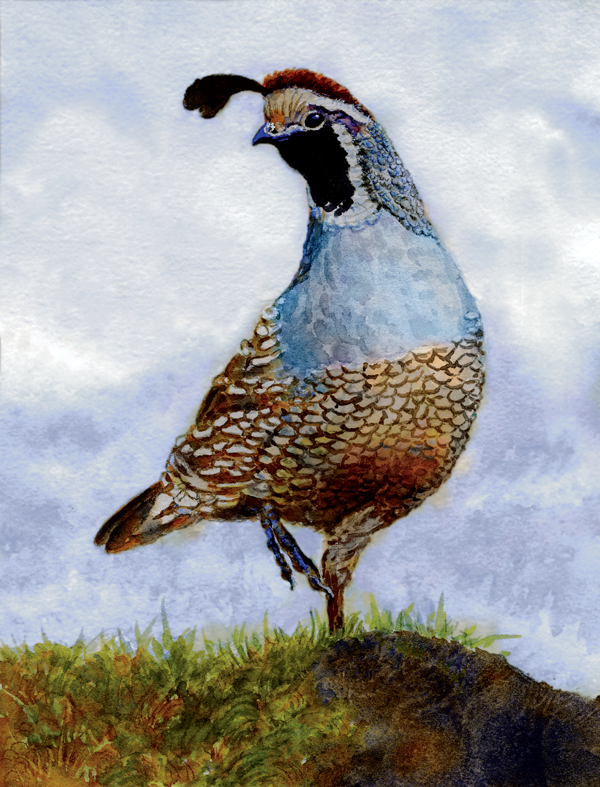
Secrets of the Oak Woodlands: Plants and Animals among California’s Oaks
by Kate Marianchild
Excerpts from the California quail chapter
Whrrrr! In the dimming shadows of dusk a covey of California quail explodes into flight, foiling the dinner plan of a stalking bobcat. The thirty-odd birds fly a dozen feet and land on the low branches of a live oak, murmuring to each other until the cat has wandered off.
With heavy bodies and strong legs, quail are designed more for life on the ground than for flight. They rarely fly farther than the nearest tree or shrub when escaping from danger. Hunted for millions of years by hawks, snakes, and mammals—including humans for the last twelve to fourteen thousand years—these birds are extremely skittish. (p. 55)
No chick left behind, talking eggs, communal childcare
Soon after they hatch, quail chicks have to follow their “ut-utting” parents out in the world. Before they hatch, therefore, they must imprint on the sound of their parents’ voices. To this end, quail parents talk to their eggs. Embryos that are almost ready to hatch also talk to the other embryos from inside their eggs. They click, peep, and chirp as if to say, “I’ll be ready to come out in about fifteen minutes; how about you?” They have the amazing ability to speed up or retard their hatching process based on the information they receive back. For the embryos to communicate, the eggs have to be touching each other.
California quail parents usually build only one nest per season and raise one batch of chicks. After the eggs have hatched, about twelve percent of families join neighboring families for communal brood rearing. No one knows whether parents or chicks trigger this merging or whether the parents are related to each other. We do know that the adults engaged in communal childcare eat more than isolated parents and don’t have to work as hard. As a result they live longer and raise more chicks during their lifetimes.
About twice a decade, in exceptional food years, a mother will lay a clutch of eggs and leave the two-week-old chicks with their father while she seeks a new mate and produces a second brood. During a drought, on the other hand, she will lay fewer eggs than usual. The reason probably lies in the fact that moisture-starved plants produce phytoestrogens that deter browsers such as deer. When quail eat these plants, the estrogens in them may interfere with the quails’ uptake of animal estrogen, resulting in lower egg production. (p.58-60)
Uses by Native Californians
Quail were a favorite food of the Pomo peoples, who, along with the Miwok, Maidu, Patwin, and other tribes, developed quail snaring and trapping to a high art form. It was common for hunters to build special fences with regularly spaced gaps fitted with nooses or long narrow cylindrical baskets. Hunters were known to build half-mile-long fences that, in spring when the birds were migrating to higher elevations, could catch fifty quail in one day.
Open at both ends, the basket traps tapered gradually from one end to the other so they could be fitted together to make long tubes. The final basket in the series was closed at the narrow end. A trail of food would lead a bird into the first basket, and all the other birds would follow until they reached the end, where they were unable to go forward and unable to turn around. Pomo inventors also applied their considerable engineering skills to the design of ingenious treadle snares and box snares. In addition to valuing quail meat, Pomo peoples also treasured quail head plumes with which they decorated exquisite baskets and clothing. (p. 60)
